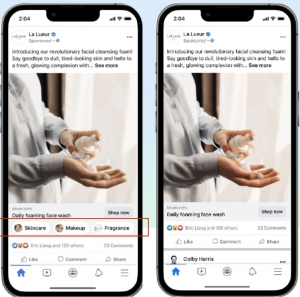Enhance Your Facebook Ad Campaigns with Site Links
- POV’s
- June 24, 2024
- Emil Møller
In today’s rapidly evolving digital landscape, businesses are faced with the challenge of capturing and maintaining consumer attention amidst a sea of online content. With users often making split-second decisions about whether to engage with an ad or continue scrolling, it’s more important than ever for businesses to provide clear, direct paths to relevant information and conversion opportunities. Streamlining consumer navigation and minimizing friction in the user journey is not just beneficial, but crucial in this high-speed digital environment. One effective way to achieve this is by incorporating site links into your Facebook ad campaigns.
What are Site Links?
Site links are a powerful feature available to advertisers on Facebook Mobile Feed. At its core, this tool allows for the addition of multiple landing pages to a single image or video ad. But what does this mean in practice?
Imagine your ad as a multi-faceted gateway. Instead of leading users to just one destination (i.e., a single landing page), it opens up several pathways that guide users directly to various sections of your website. These pathways are what we refer to as ‘site links’.
Each site link corresponds to a different landing page that you choose. This could be any page on your website – from product categories and individual items to blog posts or contact forms. Essentially, any page that you believe would be of interest to your target audience can be turned into a site link.
When someone interacts with your ad by clicking on the main creative, the call-to-action (CTA) button, or the footer, they are redirected to your primary website destination. This is the main pathway and functions much like a traditional ad without site links.
However, the real magic happens when a user clicks on an individual site link. Instead of being taken to the primary destination, they are redirected to the specific landing page you’ve set up for that link. This redirection occurs within the in-app browser, providing a seamless experience for the user.
In essence, site links transform your single ad into a multi-destination platform. They provide a way for you to highlight and direct traffic to different areas of your website all within one ad campaign, effectively turning your ad into a mini directory of your most relevant and engaging content.
Benefits of Site Links
Using site links in your Facebook ad campaigns can give you several benefits. These benefits include:
- Enhanced user experience: Site links provide users with a more dynamic and personalized browsing experience. By offering multiple pathways within a single ad, you allow users to choose their own journey based on their interests. This level of user autonomy can significantly enhance their engagement with your ad.
- Increased exposure for your content: With site links, you can highlight different categories, products, or pages all within one ad campaign. This means you can showcase a wider range of your offerings without having to create separate ads for each one. This not only saves time and resources but also ensures that your audience is exposed to a broader spectrum of your content.
- Improved conversion rates: By providing direct paths to various landing pages, site links can help reduce the steps a user needs to take to convert. This streamlined navigation can lower the chances of drop-offs and increase the likelihood of conversions. Whether it’s making a purchase, signing up for a newsletter, or filling out a contact form, users can reach their destination faster and easier.
- Greater insights into user behavior: Site links can also provide valuable data about your audience’s preferences and behavior. By analyzing which links get the most clicks, you can gain insights into what aspects of your business or content are most appealing to your audience. This information can be used to refine your marketing strategy and make more informed decisions.
- Flexibility and customization: Site links offer a high degree of flexibility and customization. You can choose which pages to highlight, tailor the display labels and icons to align with your brand, and even manually input additional URLs beyond those suggested by Meta’s dynamic scraping. This allows you to adapt your ads to suit your specific goals and audience needs.
Implementing Site Links
Implementing site links in your Facebook ad campaigns involves more than just adding multiple landing pages to your ads. It’s crucial to test their effectiveness and impact on your campaign’s performance. The key to this is setting up an A/B test, which allows you to compare two versions of your campaign and determine which one performs better.
In the context of site links, the A/B test involves creating two different campaign groups. The first group, referred to as ‘Business as Usual’, features your standard image or video creative with a single landing page linked to the CTA. This represents your typical ad setup without site links.
The second group, known as the ‘Test’ group, includes the same hero image or video but with the addition of horizontally scrollable site links below it. These site links are automatically sourced, but there’s also an option for manual review, inputs, and customization.
To ensure a fair comparison, allocate an equal amount of your budget to both groups. This way, you can accurately measure the impact of site links on your campaign’s performance.
The success of the test is determined by comparing key metrics between the two groups. These may include click-through rate (CTR), cost per landing page view, or cost per conversion. By analyzing these metrics, you can gain valuable insights into how site links influence user engagement and conversion rates.
Through this testing process, you can make data-driven decisions about whether and how to incorporate site links into your future ad campaigns. Remember, the goal is not just to drive traffic, but to create a more engaging and efficient user experience that ultimately leads to higher conversion rates.
If you would like to learn more about Site Links then feel free to reach out to Emil Møller, Senior Social Strategy Specialist at [email protected]

